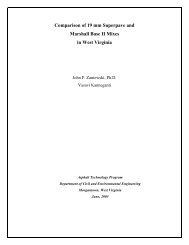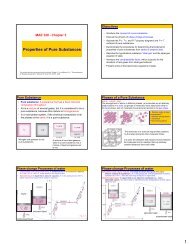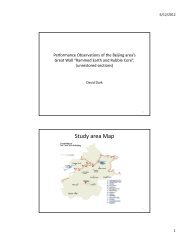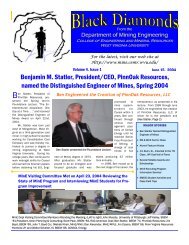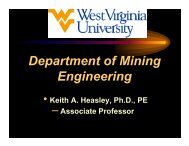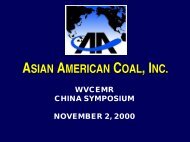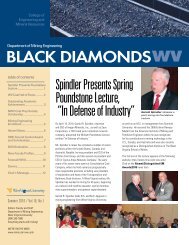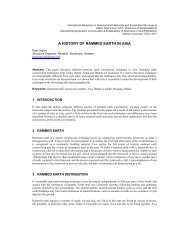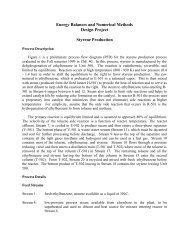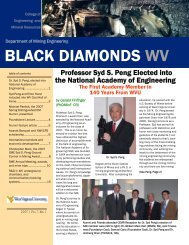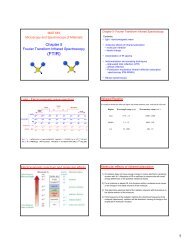Comparison of 9.5 mm SuperPave and Marshall Wearing I Mixes in ...
Comparison of 9.5 mm SuperPave and Marshall Wearing I Mixes in ...
Comparison of 9.5 mm SuperPave and Marshall Wearing I Mixes in ...
Create successful ePaper yourself
Turn your PDF publications into a flip-book with our unique Google optimized e-Paper software.
59were made, the samples were removed from the reta<strong>in</strong><strong>in</strong>g molds <strong>and</strong> discarded. This processwas repeated for twelve APA runs <strong>and</strong> data recorded for all test runs.5.3.3 APA Test<strong>in</strong>g ResultsRut depths were measured <strong>and</strong> recorded for each sample <strong>of</strong> every mix design tested. The fourrut depths per sample were averaged <strong>and</strong> these values for the triplicate samples were alsoaveraged to get one average rut depth for each mix design. St<strong>and</strong>ard deviation was alsocalculated over the sample set <strong>of</strong> data po<strong>in</strong>ts consist<strong>in</strong>g <strong>of</strong> the <strong>in</strong>dividual rut depths on eachsample. Table 5.6 conta<strong>in</strong>s these results <strong>and</strong> data on average percent air voids for each sample.These results show that the hypothesis <strong>of</strong> mixes that conta<strong>in</strong> natural s<strong>and</strong>s would exhibitgreater rut depths than mixes that conta<strong>in</strong> all limestone was correct, however, some <strong>in</strong>terest<strong>in</strong>g<strong>and</strong> contradict<strong>in</strong>g results were also observed. One <strong>in</strong>terest<strong>in</strong>g result was that the Superpavemedium 13% natural s<strong>and</strong> mix <strong>in</strong>curred an average rut depth <strong>of</strong> 9.43<strong>mm</strong> while the heavy design<strong>of</strong> the same natural s<strong>and</strong> content had an average rut depth <strong>of</strong> 10.35<strong>mm</strong>. In theory, a heavy mixdesign should be less likely to rut than a medium traffic design <strong>of</strong> the same gradation. Anotherunexpected result was that both Superpave light 100% limestone s<strong>and</strong> mixtures performedbetter than all the other mixes, with the exception <strong>of</strong> the 100% limestone s<strong>and</strong> <strong>Marshall</strong>designs. This is especially <strong>in</strong>terest<strong>in</strong>g <strong>in</strong> that the Superpave light 100% limestone s<strong>and</strong> designwas passed through the restricted zone. By do<strong>in</strong>g this, the mixture should have exhibited thecharacteristics <strong>of</strong> a tender mix (i.e. high rut depths).As expected the designs conta<strong>in</strong><strong>in</strong>g very high percentages <strong>of</strong> natural s<strong>and</strong> exhibited very high rutdepths. This was particularly true with the Superpave light 40% natural s<strong>and</strong> <strong>and</strong> 68% naturals<strong>and</strong> mixtures. These mixes resulted <strong>in</strong> the deepest rut depths <strong>of</strong> all the mix designs. It shouldbe noted that most <strong>of</strong> the samples tested failed the Georgia DOT requirement if a maximum <strong>of</strong>7.5<strong>mm</strong> rut depth. However, well perform<strong>in</strong>g mixtures designed for the WVDOH typically exhibitaverage rut depths greater than 7.5<strong>mm</strong>. This shows that the maximum rut depth requirementwould need reexam<strong>in</strong>ed if this test was ever implemented <strong>in</strong> West Virg<strong>in</strong>ia. Rut depth data,along with all other test results <strong>and</strong> data developed dur<strong>in</strong>g this research, will be further analyzed<strong>in</strong> the next chapter.



